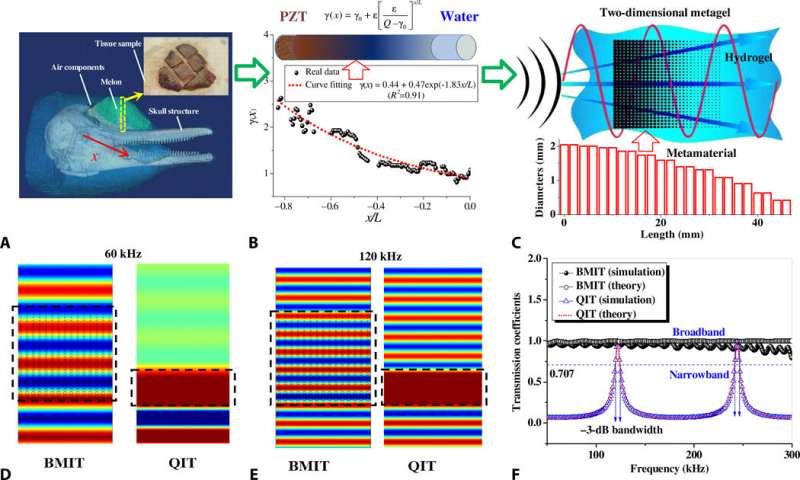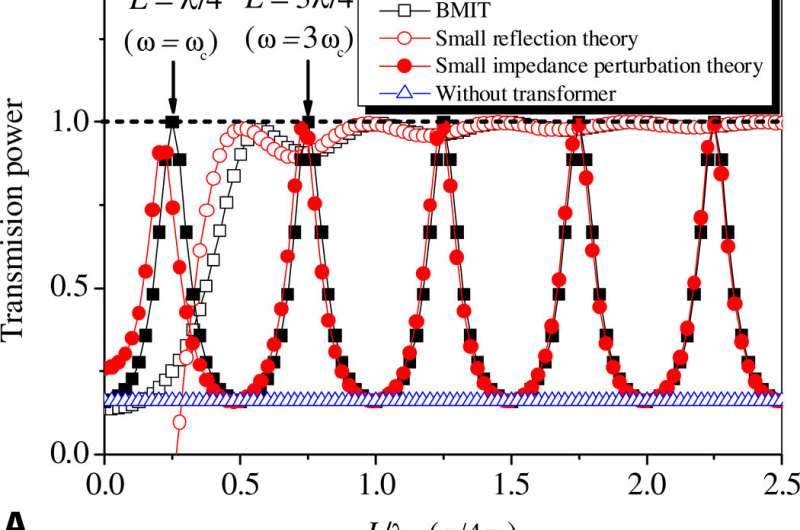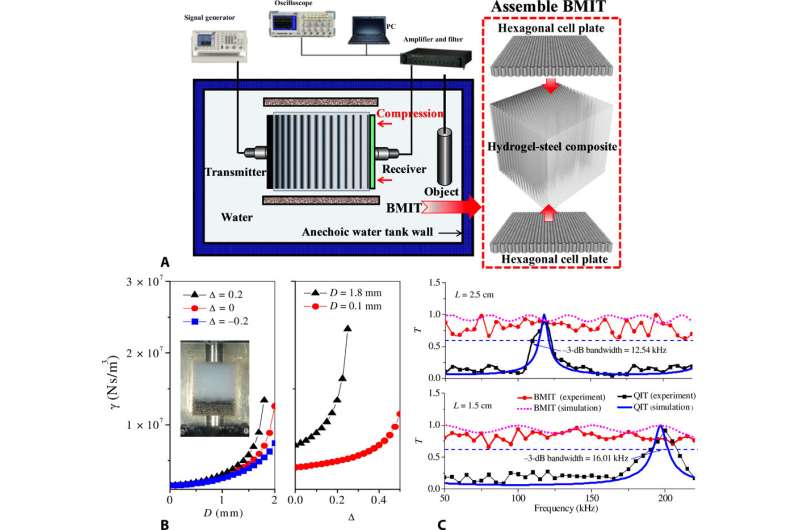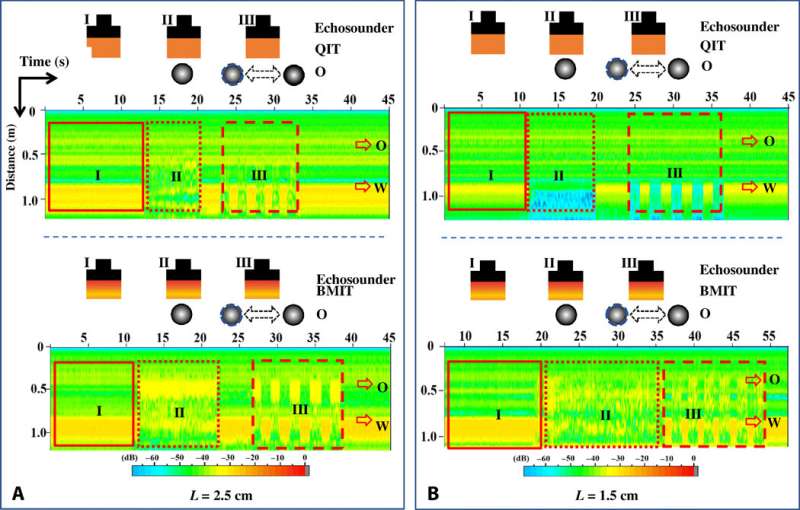November 10, 2020 feature
Bioinspired metagel with broadband tunable impedance matching

Impedance matching is a concept that can maximize energy transmission from a source through a media, and is established across electrical, acoustic and optical engineering. It is frequently necessary to match a load impedance to the source or internal impedance of a driving source. The existing design to facilitate acoustic impedance matching is fundamentally limited by narrowband transmission (data transfer with a slow or small transfer rate). In a new report now published on Science Advances, Erqian Dong and a research team in China and the U.S. detailed a previously unknown class of bioinspired metagel impedance transformers to bypass the existing limits, by developing a transformer embedded in a metamaterial matrix of steel cylinders within hydrogel. The team then theoretically analyzed broadband transmission after introducing bioinspired acoustic impedance (the product of the density of porous media through which a sound wave travels and the velocity of the sound wave) and conducted experiments with the device to show efficient implementation of the metagel during underwater ultrasound detection experiments. The experimental construct maintained a soft, tunable composition and will pave a new and unexpected way to design next-generation broadband impedance matching devices for diverse wave-engineering applications.
Metamaterials and acoustic materials
Impedance matching can maximize energy transmission between two mismatching media. In the 1920s, Bell laboratories discovered the importance of impedance matching to facilitate transcontinental telephone communication and researchers have since designed multiple layers and acoustic metamaterials to achieve tunable and broadband transmission. However, it is still challenging to overcome the narrowband transmission. In wired channels, narrowband indicates a sufficiently narrow channel where the frequency response is considered flat with a slow data transfer rate. In this work, Dong et al. reported a strategy to overcome narrowband limits with a bioinspired metagel impedance transformer (known as BMIT)—bioinspired by the sonar systems of dolphins used for echolocation in underwater environments. To accomplish the expected impedance distribution, Dong et al. embedded hydrogel into a matrix of steel cylinders to design and build a metamaterial. Metamaterials are a powerful tool to program and design the physical properties of microstructures and provide a variety of new effects including negative diffraction for invisible cloaking and other extraordinary transmissions. Hydrogels are also potential candidates for such applications due to their soft, wet and biocompatible nature. Such material can be used to establish broadband acoustic transmission between two mismatched media. The new construct therefore integrated the features of both a metamaterial and hydrogel.

Dong et al. reconstructed the gradient acoustic impedance distribution located in the head of an Indo-Pacific humpback dolphin using computed tomography scanning followed by tissue experiments to obtain the gradient acoustic impedance distribution within the dolphin's head. The scientists transmitted a broadband spectrum through the channel and computed the acoustic impedance function of BMIT relative to the biosonar properties of the dolphin. The core structure of the construct maintained low acoustic impedance and acted as an acoustic channel to guide the energy flux along. The team mimicked the deformable forehead of the dolphin using metagel structures and tuned the impedance profile of the material by compressing the hydrogel to accomplish effective acoustic impedance. Dong et al. showed that the BMIT achieved broadband impedance matching by comparing the simulated acoustic fields of BMIT and the quarter-wave impedance transformer (QIT)—typically used to maximize energy transmission. The 2-D metagel developed to mimic bioinspired impedance had the advantage of broadband matching.

Revealing the impedance matching mechanism of BMIT.
The team conducted further investigations to understand impedance matching mechanisms of BMIT. For instance, dolphins can manipulate the acoustic transmissions of their biosensor through acoustic impedance distributions in their foreheads, where a soft impedance matching system can transmit broadband signals into water. Connective tissues of the dolphin's forehead resemble a complex horn-like structure in the posterior forehead region, which contains the highest acoustic impedance. As a result, dolphins can adjust their forehead muscles through facial muscle compression to achieve tissue deformation and manipulate acoustic directivity. According to transformation acoustics (a tool that shows the precise material properties needed to specifically manipulate sound waves), the impedance function could be transformed through acoustic characteristic impedance based on geometric deformation. In this instance, the metagel represented a compressed-space version of the dolphin's horn structure and offered acoustic-solid coupling for the underwater device.

Proof of concept
The scientists verified broadband impedance matching applications of BMIT by experimentally developing a 2-D hexagonal array of steel cylinders embedded in agarose hydrogel. The acoustic impedance of the agarose hydrogel was relatively similar to the dolphin's tissue. To tune the acoustic impedance of the resulting BMIT, the team changed the filling ratio of metallic cylinders or compressed the constituent hydrogel. They then performed underwater ultrasound transmission experiments in a water tank and compared the transmitted acoustic signals of QIT (quarter-wave impedance transformer) and BMIT (bioinspired metagel impedance transformer), where the experimental results agreed with numerical simulations. The team then performed underwater ultrasound detection by using BMIT and QIT to couple an echosounder transducer with water (a device to send out sound waves and receive echoes). They noted that BMIT transmitted higher intensity signals and achieved longer detection distances. The BMIT material showed better performance compared to QIT under similar acoustic incident intensity; therefore, Dong et al. advocated for its use in broadband impedance matching functions for underwater sensing applications.
In this way, Erqian Dong and colleagues showed how the bioinspired metagel impedance transformer (BMIT) overcame the narrowband limit by breaking the length-wavelength dependency. The team developed this bioinspired device by mimicking the biosonar of dolphins. While the dolphin's biosonar is a complex 3-D impedance transformer, the bioinspired 2-D metagel allowed broadband impedance matching to enhance energy transmission. The combined bioinspired hydrogel and metamaterial device offered attractive features for effective tunability. The acoustic impedance of the metagel can be adjusted by assigning different levels of compression while still maintaining constant broadband acoustic transmission. In this way, BMIT provided a new framework to design a broadband impedance transformer for high-resolution sonar or radar. This work will have significant impact on diverse areas including acoustics, electronics, mechanics and in electromagnetism.
More information: Erqian Dong et al. Bioinspired metagel with broadband tunable impedance matching, Science Advances (2020). DOI: 10.1126/sciadv.abb3641
Jeong-Yun Sun et al. Highly stretchable and tough hydrogels, Nature (2012). DOI: 10.1038/nature11409
Wisniewska D.M. et al. Range-dependent flexibility in the acoustic field of view of echolocating porpoises (Phocoena phocoena). eLife, doi.org/10.7554/eLife.05651.002
Journal information: Science Advances , Nature
© 2020 Science X Network





















